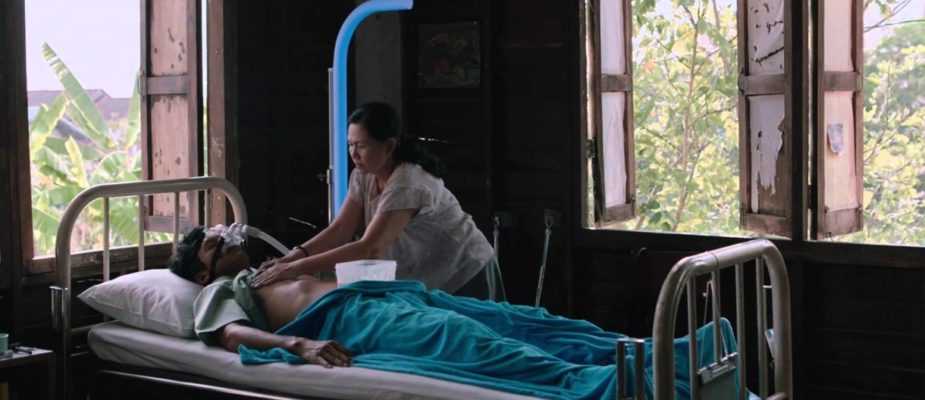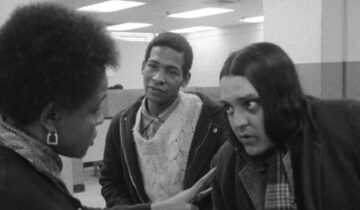Set in the Isan region of northeastern Thailand–the childhood home to one of the world cinema’s greatest living directors, Apichatpong Weerasethakul–Cemetery of Splendor (2015) centers on a temporary rural hospital that houses soldiers with a mysterious sleeping illness. Among those who pass in and out of this makeshift space are a medium who contacts the spirits of murder victims, and Jen (Jenjira Pongpas, Uncle Boonmee Who Can Recall His Past Lives, 2010), an Apichtapong regular who returns to the director’s ever-expanding multiverse as a caregiver on crutches.
Between the hospital set-pieces–which additionally feature Banlop Lomnoi in a reprisal of his soldier’s role from the director’s Tropical Malady, 2004; Apichatpong is ever the most Balzacian of contemporary filmmakers in his inter-fictional carry-over from film to film–Apichatpong scatters set-ups of a backhoe and excavation site, a Buddhist shrine covered in animal figurines, and a movie theater featuring a sudsy, supernatural Thai horror clip, beside digressive story-lines featuring disguised princesses and other figures from Thai folklore. Cemetery of Splendor, in other words, provides a meeting ground for ethnographic observation, a taste for kitsch, and non-patronizing presentations of Thai myth and Eastern metaphysics. This is a film where the ancient comes into contact with the postmodern–much in the same way that the two coexist in a broader Southeast Asian setting (and in previous directorial efforts like the magisterial Syndromes and a Century, 2006).
The past and future-present equally interact on the “hospital” floor, in this space of exquisite indeterminacy, where waking and dream seem to lose their concrete separateness. Indeed, as the soldiers suddenly slip, without warning, into suspended consciousness, we become aware of a similar process at work on the level of the story-line, where characters like the aforementioned princesses materialize in what would at first seem observational art cinema. To put it in terms that take their cue from the film’s speculative dialogue, stories metabolize a bit more lethargically in this masterwork of slow cinema, in this dream world that doesn’t feel like a dream world… that, in the glow of the upside-down, neon “l”-lights, feels like a dream world. In Cemetery of Splendor we are within the domain of the lightly surreal, one might almost say imperceptibly or invisibly so, were it not for the amoeba that seems suddenly to appear in the sky, or perhaps in crystal clear water.
A surrealist framework also does much to explain the film’s more minor emphasis on bodily movements, as does both the film’s medical subject–here again we see the director’s semi-biographical Syndromes and a Century; Apichatpong’s parents were rural doctors–and also its broader commitment to the broad substance of life as it is lived in this place, something that we see equally in the meals that Jen shares with the ailing soldier. Of course, the very presence of these men also speaks to a darker present-day reality: to the 2014 military coup, which eventually received the endorsement of the royal family in May of that year. For all the characteristic comedic lightness and warmth that marks Apichatpong’s latest effort, there is a disconcerting political sickness that hides in plain slight; it is a dream, as Jen realizes, from which the film’s subjects are struggling to wake.
All in all, Cemetery of Splendor is an expansive masterwork–certain to be among the year’s absolute best–from one of the most exciting directors working anywhere in the twenty-tens. On full display in this, the director’s eighth feature, we bear witness to a now mid-career filmmaker who has proven to be a master of counter-intuitive camera placement, with his striking camera angles and long compositions drawing every ounce of interest out of his remote country settings. We are also witness, once again for the director of the supreme Uncle Boonmee, to a work built out of the tissue of Apichatpong films past, in this case especially bringing together the director’s Tropical Malady and Syndromes and a Century/Uncle Boonmee.
It is also a film very much about its own conditions of production: Cemetery of Splendor rehearses its own minimal means in the multifaceted ways in which places and figures stand in for each other (with the film’s virtual trip through the palace providing the most spectacular example of both). Apichatpong’s film, of course, is also aware of how very different it is from more standard Thai cinema–see again the in-film trailer.
Finally, there are the extraordinary variety of textures and storytelling modes that the filmmaker introduces in his latest. The most spectacular, no doubt, is the film’s sudden and excessively digressive panorama of neon that skips dramatically from one space to the next, from placid rural locales to ultra-modern urban spaces that fall well beyond the film’s immediate setting and medical subject. Here, the author of a number of gallery projects (see 2009’s Primitive) has created one of recent cinema’s most beautiful intervals of pure cinema, constructing nothing so much as a discrete piece of installation art within the middle of his surreal narrative masterwork.










